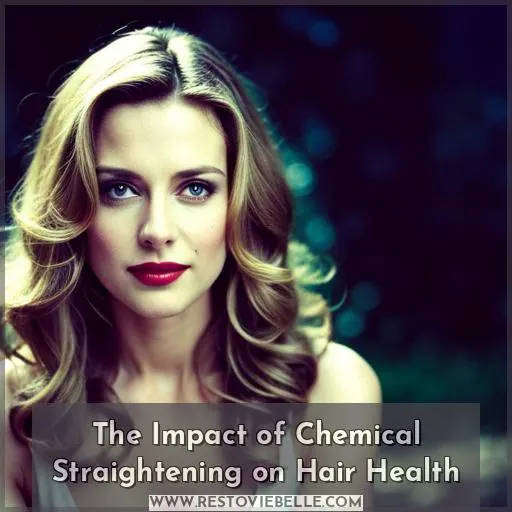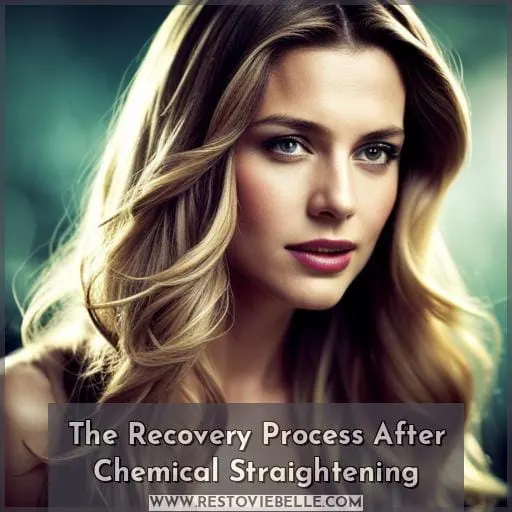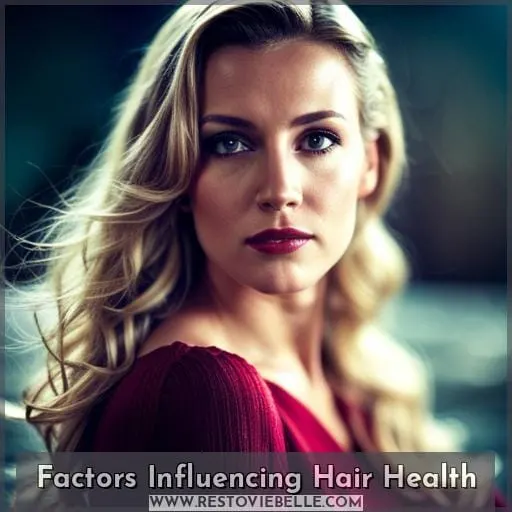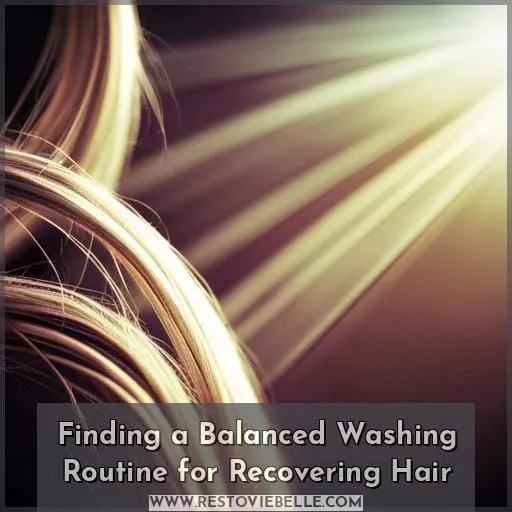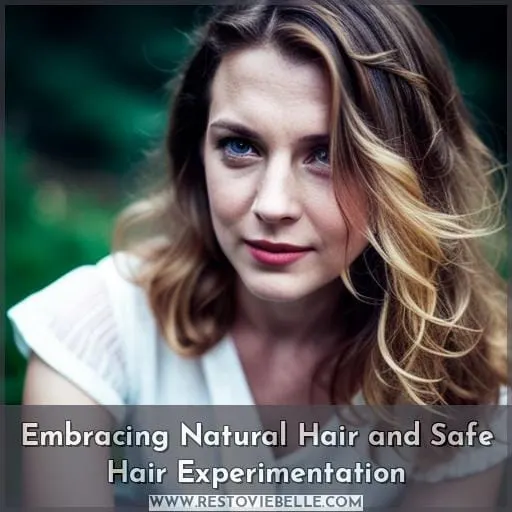This site is supported by our readers. We may earn a commission, at no cost to you, if you purchase through links.
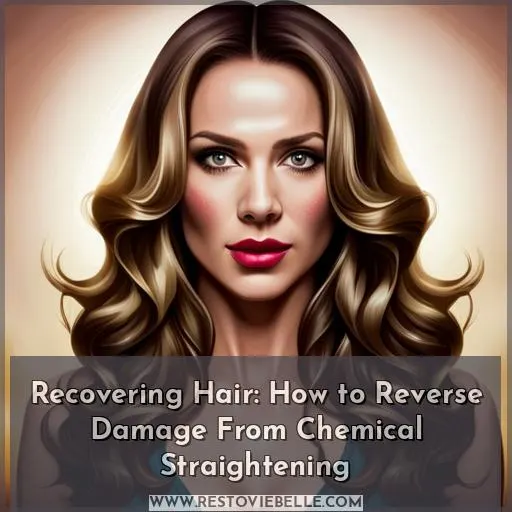 Ready to reclaim the power of your hair? Chemical straightening can have a major impact on the health of your locks, but there are ways to recover from this type of treatment. In this article, we’ll discuss how you can reverse years worth of damage from chemical straightening and get back healthy strands.
Ready to reclaim the power of your hair? Chemical straightening can have a major impact on the health of your locks, but there are ways to recover from this type of treatment. In this article, we’ll discuss how you can reverse years worth of damage from chemical straightening and get back healthy strands.
We’ll look at transitioning techniques for regrowth as well as factors that influence hair health such as hormonal influences and environmental factors like weather conditions.
Table Of Contents
Key Takeaways
- Recovery from chemical straightening is a gradual process that requires patience.
- Balancing moisture and cleansing is a challenge during hair recovery.
- Hormones and environmental factors play a significant role in hair health and recovery.
- Having a strong support network, including family and friends, is crucial in embracing natural hair and the recovery process.
The Impact of Chemical Straightening on Hair Health
The harsh realities of chemical straightening, from potential cancer risks to difficult hair recovery journeys, may leave you feeling discouraged and uncertain about your beauty. But with the right knowledge and products, understanding how to recover after years of chemical straightening can be a liberating process.
It’s important to recognize that regrowth isn’t an overnight process—it requires patience as well as experimentation with different hair products for desired results.
With an open mind but no rush attitude, find what works best for your unique curls by researching natural ingredients or trying out silicone-free shampoos like Function of Beauty’s range.
The journey towards embracing natural hair will also include finding balance when washing; aim for lightness without weighing down locks nor drying them out completely so they feel moisturized yet clean post-shower if possible!
Finally, don’t forget there is always room to evolve—just because something worked today doesn’t mean it’ll work tomorrow. Whether you’re taking advice from Nathalie Meertens’ Instagram page or following tips from friends/family members who have gone through similar transformations—make sure all information gathered follows safety regulations while considering individual needs and weather conditions too.
The Recovery Process After Chemical Straightening
After years of chemical straightening, the recovery process can be difficult and emotional. Regrowth may start soon after treatments stop, but transitioning to natural hair requires patience and experimentation with different products.
It’s easy to feel self-doubt or dissatisfaction during this phase; however, it is possible to achieve beautiful results that reflect your true identity.
Hair Regrowth and Transitioning
After enduring chemical straightening, you can experience the journey of regrowth and transitioning—a process that moves at an agonizingly slow pace. Tips for success include: 1) Patience; 2) Experimenting with different hair products; 3) Allowing your hair to breathe; 4) Understanding factors impacting growth like hormones and weather conditions; 5) Acknowledging the power of self-doubt and embracing it.
Transitioning from chemically treated to natural curls requires commitment but ultimately leads towards freedom, empowerment, and mastery over your own body image.
Dealing With Self-Doubt and Appearance Dissatisfaction
Struggling with self-doubt and appearance dissatisfaction can be a daunting part of the transition away from chemical straightening. To cope, many turn to beauty standards for guidance. Understanding that these ideals are often unrealistic is key to accepting your natural hair journey.
Embrace experimentation—from products to application methods—to discover what works best for you as an individual without succumbing to societal pressures or expectations.
Experimenting With Hair Products and Treatments
Exploring different products and treatments can help you nourish your hair to its fullest potential. Experiment with a variety of items, from silicone-free shampoo and conditioner to post-shower styling aids, for a balanced routine that enhances natural curls.
With patience comes rewards: regrowth after transitioning away from chemical straightening or relaxers is possible! Hair experiments are important—just be mindful of the chemicals in certain products that may increase cancer risk, like parabens, bisphenol A, metals, and formaldehyde.
Factors Influencing Hair Health
You’re likely aware of the importance of hormones in hair health – they can impact the rate at which your hair grows, its texture, and thickness. However, environmental factors such as weather conditions are equally influential in how your strands recover after chemical straightening treatments.
From humidity to sunlight and temperature fluctuations, these elements all have a role to play when it comes to restoring balance.
Hormonal Influences on Hair
Discover how hormones can affect the health of your locks and determine what steps you should take to keep them healthy. Hormonal imbalances in your body, like those triggered by menopause or pregnancy, can cause changes in hair texture and growth rate.
Weather effects such as humidity levels also play a role since too much moisture makes it difficult for oils from the scalp to reach strands. When transitioning away from chemical straightening, it’s important to consider women’s cancer risk when choosing products with specific chemicals that may contribute to uterine cancer risk.
Experimenting safely with different treatments is key – try out silicone-free shampoos and conditioners while maintaining a balanced washing routine that leaves hair feeling light, moisturized, and clean! Finally, educate yourself on transitioning tips shared online by other individuals who have gone through similar experiences.
Weather and Environmental Factors
Navigating the impact of weather and environmental factors on your hair health can be like riding a roller coaster – unpredictable and full of unexpected twists. Humidity plays a major role in both natural curls as well as chemically straightened hair, with higher levels causing frizziness to become more pronounced.
As black women are often required to keep their straightening treatments up-to-date due to frequent regrowth, this cycle can be especially damaging when combined with chemical exposure from certain products.
Environmental conditions also influence other beauty standards. Dry or cold air may require extra conditioning while hot climates tend to make scalp oils evaporate faster. Addressing these climate effects is key for maintaining healthy strands and reducing health disparities associated with certain hairstyles or styles that rely heavily on chemical processes like hair dyeing and bleaching.
Taking control over your individual needs through awareness of resilience patterns encourages longevity in all types of locks, no matter how you choose them!
Finding a Balanced Washing Routine for Recovering Hair
Are you trying to recover from years of chemical hair straightening? Finding the perfect washing routine for your hair can be a challenge. Balancing moisture with cleansing products, using post-shower remedies to balance imbalances, and finding a routine that works best for you are all important factors in recovering healthy curls.
The Challenge of Balancing Moisture and Cleansing
Managing the delicate balance between moisture and cleansing is a challenge for those recovering from chemical straightening treatments. Hair hydration, transitioning tips, and natural hair care can help restore your hair’s health.
Understanding how to use different cleansers, conditioners, oils, and masks in tandem is essential as well. Avoid washing too frequently or using products that strip away moisture; instead, seek out gentle formulas meant to replenish lost hydration while still providing a deep cleanse.
Post-Shower Products for Hair Imbalances
Exploring post-shower products to correct imbalances in your hair is like sailing across a sea of possibilities. Hair imbalance solutions, such as moisture restoration and scalp health treatments, can help you achieve the desired results.
Choosing the right product for your hair type is essential; consider options such as leave-ins or deep conditioners that target specific needs.
The Role of a Perfect Washing Routine
Fine-tuning your washing routine can help balance the imbalances in your hair and lead to a healthier look. Moisture management is key – a good shampoo and conditioner combo, plus weekly deep conditioning treatments.
Detangle while wet with wide-toothed combs or fingers for minimal breakage. Experiment with products that do not contain silicones – they block moisture! Rinse thoroughly, then apply leave-in conditioners or oils depending on the needs of your hair type after showering.
Embracing Natural Hair and Safe Hair Experimentation
It’s no secret that societal beauty standards have long influenced people to embrace chemical hair straightening. However, with the right family and peer support, it is possible to recover from years of such treatments and safely transition back to natural hair.
The Influence of Societal Beauty Standards
Navigating societal beauty standards can be a slippery slope, and embracing natural hair is no exception. Cultural expectations have long influenced African Americans to chemically straighten their hair in order to fit into mainstream society’s idea of beauty.
The Natural Hair Movement has since inspired many individuals, especially Black women, to accept and love their own unique curls as a form of self-expression and identity.
Nevertheless, this process isn’t always easy given the pressure from cultural norms that may still exist today:
- Criticisms over appearance
- Family dynamics
- Fear of judgment
- Pressure for social acceptance
Even with its challenges though, recognizing one’s true hair identity can provide an incredible sense of freedom—empowering us all to redefine our beauty ideals on our own terms!
The Importance of Family and Peer Support
Relying on the support of family and friends can be integral to embracing your natural hair journey. Peer influence is important, as hearing others’ stories of success can give you more confidence in transitioning away from chemical straightening.
It’s never easy to let go of societal beauty standards, but having a strong network around you makes it easier. Reminding yourself that true beauty lies within and embracing the potential for growth alongside them helps make hair recovery enjoyable rather than daunting.
Promoting Safe and Healthy Hair Practices
Exploring the options for safe and healthy hair practices is key to maintaining a strong, balanced mane. Transitioning tips, such as minimizing heat styling, can help restore natural texture over time.
Ensuring a healthy scalp with silicone-free shampoo allows moisture to penetrate deep into the hair shafts while preventing buildup of chemicals from products used in chemical straightening processes.
Try different styling techniques that are tailored towards your unique needs. These techniques vary depending on the length, curl pattern, or thickness of each individual’s locks! Experimenting with new methods can be fun but also requires patience and caution.
Always consider potential long-term effects before committing to any change in routine.
Promoting health should be at the forefront when searching for ways to enhance one’s look!
Conclusion
Surprisingly, chemical straightening of hair, which has been heavily relied upon to conform to societal beauty standards, might be the cause of hair damage. The process of recovering hair takes time and patience and requires experimentation with products to find the right balance of moisture and cleansing.
Additionally, environmental and hormonal influences may affect the hair’s recovery. With support from family and friends, transitioning to natural hair can be a journey of self-discovery and self-love.
It’s important to remember to practice safe experimentation with hair routines and products and to be aware of the potential risks of chemical straightening to ensure hair health and recovery.
